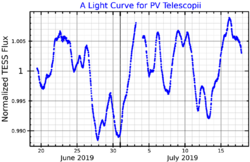Astronomy:PV Telescopii
| Observation data Equinox J2000.0]] (ICRS) | |
|---|---|
| Constellation | Telescopium |
| Right ascension | 18h 23m 14.66203s[2] |
| Declination | −56° 37′ 44.1401″[2] |
| Apparent magnitude (V) | 9.30[3] (9.24 - 9.40)[4] |
| Characteristics | |
| Spectral type | B5p[5] |
| U−B color index | −0.60[3] |
| B−V color index | −0.10[3] |
| Variable type | PV Tel[4] |
| Astrometry | |
| Radial velocity (Rv) | −169[6] km/s |
| Proper motion (μ) | RA: −1.086[2] mas/yr Dec.: −7.705[2] mas/yr |
| Parallax (π) | 0.1162 ± 0.0449[2] mas |
| Distance | 23,000 ly (7,100+1,400 −2,000[1] pc) |
| Absolute magnitude (MV) | −4.4[7] |
| Details | |
| Mass | 0.94[8] M☉ |
| Radius | 27.20+4.09 −7.26[1] R☉ |
| Luminosity | 24,000+8,600 −9,900[1] L☉ |
| Surface gravity (log g) | 1.60±0.25[1] cgs |
| Temperature | 13,750±400[1] K |
| Metallicity [Fe/H] | −0.15[9] dex |
| Other designations | |
| Database references | |
| SIMBAD | data |
PV Telescopii, also known as HD 168476, is a variable star in the southern constellation of Telescopium. It is too dim to be visible to the naked eye, having an apparent visual magnitude that has been measured varying from 9.24 down to 9.40.[4] The star is the prototype of a class of objects called PV Telescopii variables. It is located at an estimated distance of approximately 23 kilolight-years (7.1 kiloparsecs) from the Sun,[1] but is drifting closer with a radial velocity of −169 km/s.[6]
This is an extreme helium star that shows a highly-processed atmosphere.[11] It is a blue-white hued B-type supergiant star with a peculiar spectrum that has "weak hydrogen lines and enhanced lines of He and C".[12][13] This object may be a late thermal pulse post-AGB star or the result of a merger of two white dwarf stars.[8][14] The star shows radial velocity changes thought to be due to radial pulsations caused by a strange mode instability.[8] It shows variations over a few days, 8–10 days being typically quoted.[8][14] Despite a mass thought to be less than the sun,[8] it is actually around 24,000 more luminous.[1]
References
- ↑ 1.0 1.1 1.2 1.3 1.4 1.5 1.6 1.7 Jeffery, C. Simon et al. (April 2020). "TESS photometry of extreme helium stars PV Tel and V821 Cen". Monthly Notices of the Royal Astronomical Society: Letters 495 (1): L135–L138. doi:10.1093/mnrasl/slaa075. Bibcode: 2020MNRAS.495L.135J.
- ↑ 2.0 2.1 2.2 2.3 2.4 Brown, A. G. A. (August 2018). "Gaia Data Release 2: Summary of the contents and survey properties". Astronomy & Astrophysics 616: A1. doi:10.1051/0004-6361/201833051. Bibcode: 2018A&A...616A...1G. Gaia DR2 record for this source at VizieR.
- ↑ 3.0 3.1 3.2 Ducati, J. R. (2002). "VizieR Online Data Catalog: Catalogue of Stellar Photometry in Johnson's 11-color system". CDS/ADC Collection of Electronic Catalogues 2237. Bibcode: 2002yCat.2237....0D.
- ↑ 4.0 4.1 4.2 Samus, N. N. et al. (2017), "General Catalogue of Variable Stars", Astronomy Reports, 5.1 61 (1): 80–88, doi:10.1134/S1063772917010085, Bibcode: 2017ARep...61...80S
- ↑ Walker, H. J.; Hill, P. W. (1985). "Radial velocities for the hydrogen-deficient star HD 168476, several helium-strong and helium-weak stars". Astronomy and Astrophysics Supplement Series 61: 303. Bibcode: 1985A&AS...61..303W.
- ↑ 6.0 6.1 Gontcharov, G. A. (2006). "Pulkovo Compilation of Radial Velocities for 35 495 Hipparcos stars in a common system". Astronomy Letters 32 (11): 759–771. doi:10.1134/S1063773706110065. Bibcode: 2006AstL...32..759G.
- ↑ Heber, U.; Schoenberner, D. (1981). "Colours and effective temperatures of extreme helium stars". Astronomy and Astrophysics 102: 73. Bibcode: 1981A&A...102...73H.
- ↑ 8.0 8.1 8.2 8.3 8.4 Jeffery, C. S. et al. (2001). "Cyclic and secular variation in the temperatures and radii of extreme helium stars". Monthly Notices of the Royal Astronomical Society 321 (1): 111–130. doi:10.1046/j.1365-8711.2001.03992.x. Bibcode: 2001MNRAS.321..111J.
- ↑ Soubiran, C.; Le Campion, J. -F.; Cayrel De Strobel, G.; Caillo, A. (2010). "The PASTEL catalogue of stellar parameters". Astronomy and Astrophysics 515: A111. doi:10.1051/0004-6361/201014247. Bibcode: 2010A&A...515A.111S.
- ↑ "PV Tel". SIMBAD. Centre de données astronomiques de Strasbourg. http://simbad.u-strasbg.fr/simbad/sim-basic?Ident=PV+Tel.
- ↑ Saio, Hideyuki; Jeffery, C. Simon (June 2002). "Merged binary white dwarf evolution: rapidly accreting carbon-oxygen white dwarfs and the progeny of extreme helium stars". Monthly Notices of the Royal Astronomical Society 333 (1): 121–132. doi:10.1046/j.1365-8711.2002.05384.x. Bibcode: 2002MNRAS.333..121S.
- ↑ Jeffery, C. Simon (March 2008). "Variable Star Designations for Extreme Helium Stars". Information Bulletin on Variable Stars 5817: 1. Bibcode: 2008IBVS.5817....1J.
- ↑ Pandey, Gajendra; Lambert, David L. (2011). "Neon and CNO Abundances for Extreme Helium Stars—A Non-LTE Analysis". The Astrophysical Journal 727 (2): 122. doi:10.1088/0004-637X/727/2/122. Bibcode: 2011ApJ...727..122P.
- ↑ 14.0 14.1 Gourgouliatos, K. N.; Jeffery, C. S. (2006). "On the angular momentum evolution of merged white dwarfs". Monthly Notices of the Royal Astronomical Society 371 (3): 1381–1389. doi:10.1111/j.1365-2966.2006.10780.x. Bibcode: 2006MNRAS.371.1381G.
 |


